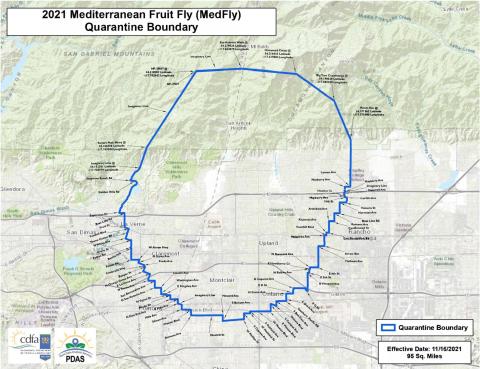
Recently the California Department of Food and Agriculture (CDFA) confirmed that an infestation of Medfly exist in San Bernardino County. This pest presents a significant threat to the natural environment, agriculture, and economy of California. An emergency Mediterranean Fruit Fly Interior Quarantine around the infestation is necessary to prevent the artificial spread of this pest to non-infested areas, while treatment measures are taken.
The tentative end date for this emergency proclamation of a treatment plan is valid through June 24, 2022, which is the amount of time needed to carry out a treatment plan across three life cycles of Medfly.
The treatment plan includes the following actions.
1.) Biological Control. The sterile insect technique (SIT) makes use of sterile medflies to prevent the production of viable offspring. The wild female medflies mate with the sterile males and lay infertile eggs, thereby disrupting the breeding cycle and causing the population to be eliminated. Sterile flies are released by aircraft within a 3.5-mile radius around each detection site. Releases are repeated every three to four days for two life cycles of the fly (typically four to six months, dependent on temperature).
2.) Augmented Biological Control. Due to the high-altitude mountain pass area with rugged terrain and topographical complexity for this project, it is possible that high winds and cold temperatures could impact SIT operations. Therefore, it is unknown if sufficient numbers of sterile medflies released by aircraft will reach the target area in good condition with the objective to overflood the population of wild male flies. To augment aerial releases of sterile flies, CDFA may use supplemental ground releases if high winds and cold temperatures impact SIT operations. Ground releases will be made by a specially designed truck and/or other ground vehicles, which will release flies from public roads.
3.) Chemical Control. Foliar bait treatments are used within 200 meters of each detection site in order to mitigate the spread of medfly by eliminating those adult life stages not directly affected by SIT (i.e., mated females and sexually immature flies). Foliar bait ground treatments are a protein bait spray that contains an organic formulation of the pesticide spinosad (GF-120 NF Naturalyte® Fruit Fly Bait) and are repeated every seven to 14 days for one life cycle of the fly (typically two to three months, dependent on temperature). Please visit the CDFA website to learn more about the treatment process at http://www.cdfa.ca.gov/plant/videos/spinosad/.
4.) Physical Control. If evidence that a breeding population exists on a property (i.e., immature stages, mated female, or multiple adults), all host fruit from each detection site and all properties within a minimum of 100 meters of each detection site may be removed and disposed of in a landfill in accordance with regulatory protocols. Fruit removal will occur at the beginning of the project, but may be repeated if additional flies are detected.
For any questions related to this program, please contact the CDFA toll-free telephone number at 1-800-491-1899 for assistance.
Additional Information and Resources
Proclamation of Emergency Program for the Mediterranean Fruit Fly
